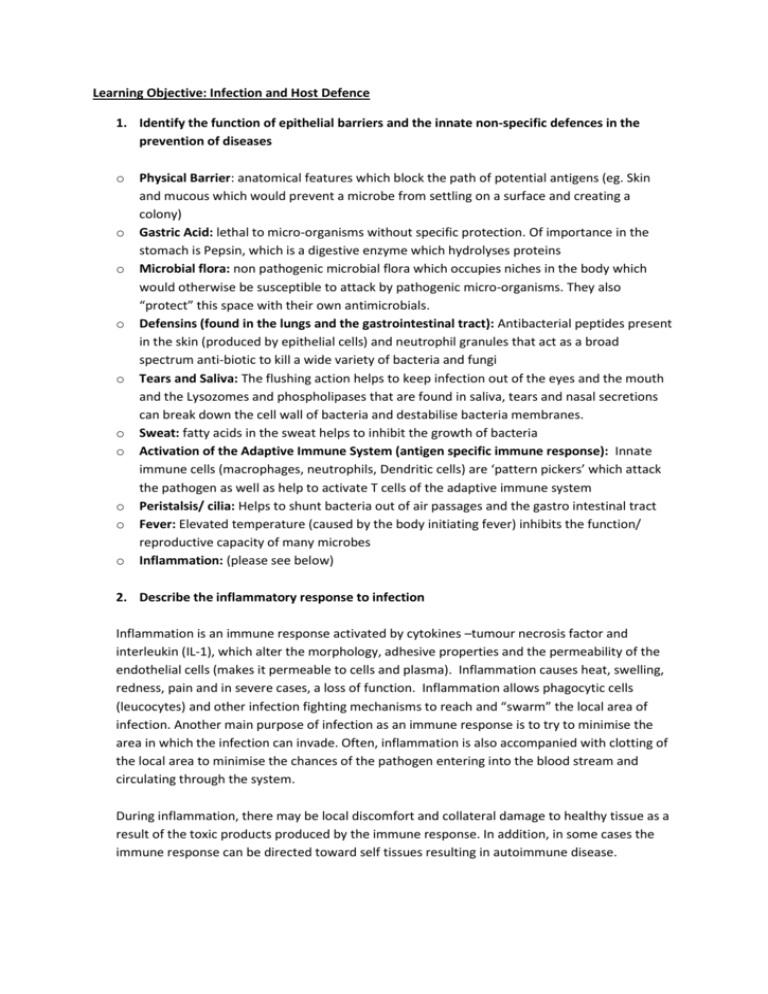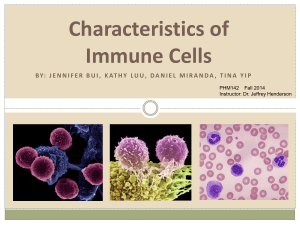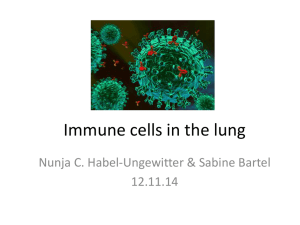File
advertisement

Learning Objective: Infection and Host Defence 1. Identify the function of epithelial barriers and the innate non-specific defences in the prevention of diseases o o o o o o o o o o Physical Barrier: anatomical features which block the path of potential antigens (eg. Skin and mucous which would prevent a microbe from settling on a surface and creating a colony) Gastric Acid: lethal to micro-organisms without specific protection. Of importance in the stomach is Pepsin, which is a digestive enzyme which hydrolyses proteins Microbial flora: non pathogenic microbial flora which occupies niches in the body which would otherwise be susceptible to attack by pathogenic micro-organisms. They also “protect” this space with their own antimicrobials. Defensins (found in the lungs and the gastrointestinal tract): Antibacterial peptides present in the skin (produced by epithelial cells) and neutrophil granules that act as a broad spectrum anti-biotic to kill a wide variety of bacteria and fungi Tears and Saliva: The flushing action helps to keep infection out of the eyes and the mouth and the Lysozomes and phospholipases that are found in saliva, tears and nasal secretions can break down the cell wall of bacteria and destabilise bacteria membranes. Sweat: fatty acids in the sweat helps to inhibit the growth of bacteria Activation of the Adaptive Immune System (antigen specific immune response): Innate immune cells (macrophages, neutrophils, Dendritic cells) are ‘pattern pickers’ which attack the pathogen as well as help to activate T cells of the adaptive immune system Peristalsis/ cilia: Helps to shunt bacteria out of air passages and the gastro intestinal tract Fever: Elevated temperature (caused by the body initiating fever) inhibits the function/ reproductive capacity of many microbes Inflammation: (please see below) 2. Describe the inflammatory response to infection Inflammation is an immune response activated by cytokines –tumour necrosis factor and interleukin (IL-1), which alter the morphology, adhesive properties and the permeability of the endothelial cells (makes it permeable to cells and plasma). Inflammation causes heat, swelling, redness, pain and in severe cases, a loss of function. Inflammation allows phagocytic cells (leucocytes) and other infection fighting mechanisms to reach and “swarm” the local area of infection. Another main purpose of infection as an immune response is to try to minimise the area in which the infection can invade. Often, inflammation is also accompanied with clotting of the local area to minimise the chances of the pathogen entering into the blood stream and circulating through the system. During inflammation, there may be local discomfort and collateral damage to healthy tissue as a result of the toxic products produced by the immune response. In addition, in some cases the immune response can be directed toward self tissues resulting in autoimmune disease. 3. Describe the cells and their functions involved in phagocytosis of invading microorganisms 1. Granulocytes (neutrophils, eosinophils and basophils) a. Neutophils Most common in the blood Their main function is to recognise, ingest and destroy foreign particles and microorganisms They have a multilobular nucleaus and granules in the cytoplasm. Two main types of granules are present; primary (or azurophil) and secondary (or specific) granules, which are the more prominent in the cell. Primary granules contain proteins for killing ingested microbes, whilst secondary granules contain a number of membrane proteins including adhesion molecules, and components of the NADPH oxidase with which neutophils produce superoxide anions (a rective oxygen species) for microbial killing Granules fuse with the plasma membrane upon degranulation and the contents are released out of the cell b. Eosinophils Represent 1-6% of the circulating leucocytes A bone-marrow derived granulocyte that are abundant in the inflammatory infiltrates and contributes to many of the pathologic processes in allergic diseases Similar to the neutophils, but have a bilobed nucleaus and prominent granules Eosinophils are phagocytic and their granules are capable of generating reactive oxygen species and proteins involved in intracellular killing of protozoa and helminths (a parasitic worm). (Reactive oxygen species help to rupture the cell wall of the infectious cells) c. Basophils Much less common than the other types of granulocytes, representing only about 1% of the circulating leucocytes Dense, black granules obscure the nucleaus Basophils bind IgE antibody on their surface and exposure to a specific antigen results in degranulation with the release of histamines (binds to specific receptors in various tissues and causes increased vascular permeability and contraction of bronchial and intestinal smooth muscle), leukotrienes (an inflammatory mediator) and heparin (an anticoagulant) Involved in hypersensitivity reactions, autoimmune diseases and allergic reactions 2. Monocytes (differentiate into macrophages) Largest of the leucocytes Irregular nucleaus in abundant cytoplasm, containing few vacuoles Monocytes migrate to the cell where they become macrophages, Kupffer cells or antigen-presenting dendritic cells They produce a variety of cytokines when activated 3. Natural Killer (NK) Cells A subset of bone marrow derived lymphocytes that function in innate immune responses to kill microbe-infected cells Activated by activated macrophages and cytokines of innate immunity Crucial in the immediate response to infection prior to T cells becoming activated NK cells are particularly important to recognise and kill cells that have been infected with viruses The NK cells attack with gransimes to create a pore on the cell and thereby causing apoptosis NK cells are also important in the activation of macrophages (the process is self perpetuating as macrophages can activate NK cells and NK cells can activate macrophages) 4. Dendritic Cells Dendritic Cells display microbial peptides to naive T lymphocytes and initiate adaptive immune responses to protein antigens Dendritic cells in the epithelia and connective tissues capture microbes, digest their proteins into peptides, and express on their surface these peptides bound to MHC molecules (specialised display molecules) Dendritic cells carry their antigenic cargo to draining lymph nodes and take up residence in the same region of the nodes through which naive T lymphocytes continuously circulate. Therefore, Dendritic cells help to concentrate the antigens in a form that is recognisable for the T lymphocytes and in a location where they are abundant NB: Phagocytosis can be described as opsonic or non-opsonic. Non-opsonic phagocytosis is mediated by cell surface receptors on leukocytes. These receptors recognise repeating patterns of carbohydtaes on the microbes. Opsonic phagocytosis is mediated by the deposit of proteins (antibodies) that make them targets for specific phagocytic receptors on leukocytes. 4. Describe the role in defence of antimicrobial peptides, reactive oxygen species and the complement system Antimicrobial Peptides (AMPs): Antimicrobial peptides (AMPs) are small molecular weight proteins with broad spectrum antimicrobial activity against bacteria, viruses, and fungi. These peptides are usually positively charged and have both a hydrophobic and hydrophilic side that enables the molecule to be soluble in aqueous environments yet also enter lipid-rich membranes. Once in a target microbial membrane, the peptide kills target cells through diverse mechanisms. Cathelicidins (found in lysosomes) and defensins are major groups of epidermal AMPs. In addition to important antimicrobial properties, growing evidence indicates that AMPs alter the host immune response through receptor-dependent interactions. AMPs have been shown to be important in such diverse functions as angiogenesis (growth of new blood vessels from pre-existing vessels), wound healing, and chemotaxis (the term used to describe the way in which single cell or multicellular organisms will move depending on the chemical stimulus in their environment – i.e. sperms swimming towards to ova, bacteria moving away from toxins). Reactive oxygen species: Highly reactive metabolites of oxygen including superoxide anion, hydroxyl radical and hydrogen peroxide that are produced by activated phagocytes. Reactive oxygen species are used by the phagocytes to form oxyhalides that damage ingested bacteria. They may also be released from the cell and promote inflammatory responses or cause tissue damage. Complement System: Definition: “A system of serum and cell surface proteins that interact with one another and with other molecules of the immune system to generate important effectors of innate and adaptive immune responses” (Abbas, et. al., 2007). The pathways of the complement system are activated by antigen-antibody complexes or microbial surfaces and consist of a cascade of enzymes (at least 20 plasma proteins) that generate inflammatory mediators and opsonins (a macromolecule that becomes attached to the surface of a microbe and can be recognised by surface receptors of neutrophils and macrophages and therefore, they increase the efficiency of phagocytosis). The complement proteins interact with one another in chain reactions or cascades to produce a rapid, highly amplified response. There are 3 complement pathways that make up the complement system; a) Classical Complement Pathway (uses a plasma protein called C1 to detect IgM, IgG1 or IgG3 antibodies bound to the surface of a microbe) b) The Lectin Pathway (triggered by a plasma protein called mannose-binding lectin (MBL), which recognises terminal mannose residues on microbial glycoproteins and glycolipids) c) The Alternative Complement Pathway (triggered by direct recognition of certain microbial surface structures and is therefore a component of the innate immune response) Although all the pathways are different, they all have the same purpose. They all do the following; Trigger inflammation Attract phagocytes to the site of infection Promote the attachment of antigens to phagocytes (this could also include using opsonisation) Lysis of gram-negative bacteria Killing of pathogens via the formation of a terminal cell lytic that is inserted into the cell membrane 5. Identify the cytotoxic action of natural killer cells against infected target cells Natural Killer Cells (NK cells) contain granules that contain protein which mediate the killing of target cells. The process is as follows; NK cells activated NK cells release these proteins via exocytosis adjacent to the target cells One of these protein granules, called perforin, facilitates the entry of all the other granule proteins into the cytoplasm of the target cells These proteins activate apoptosis of the infected cell NK Cells also activate macrophages and thereby promotes the activation of phagocytosis. This is a self perpetuating loop, as macrophages activate NK Cells and NK Cells activate macrophages. Useful resource for further information: Abbas, A.K., Lichtman, A.H., Pillai, S., 2007, Cellular and Molecular Immunology, Ed. 6, Saunders Elsevier, China








